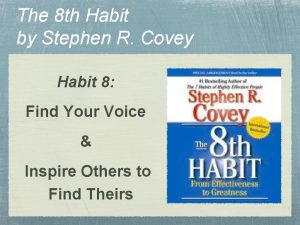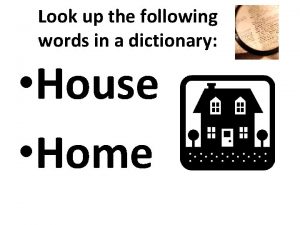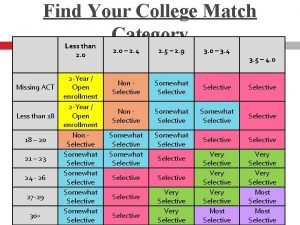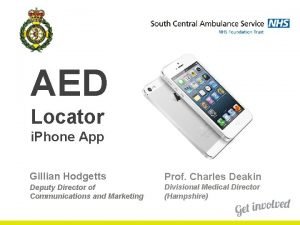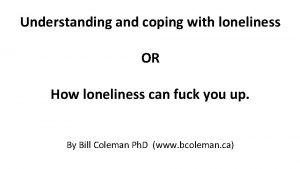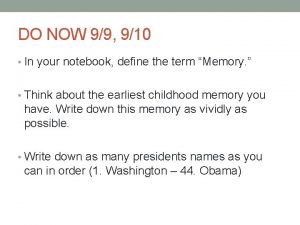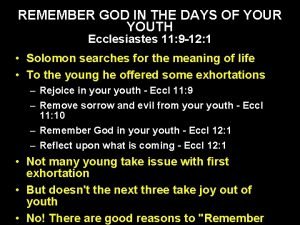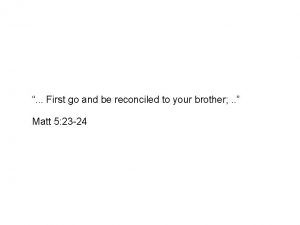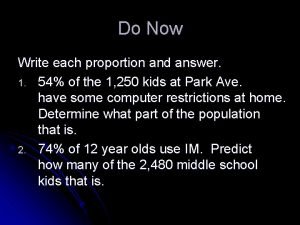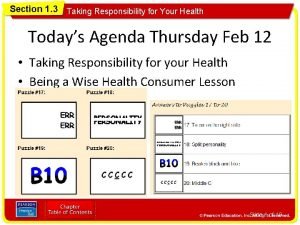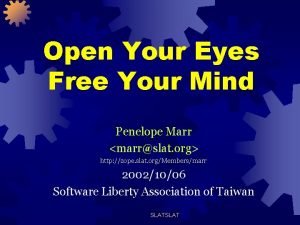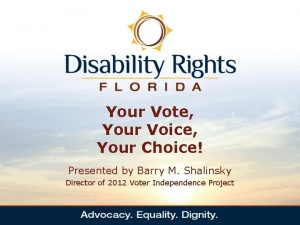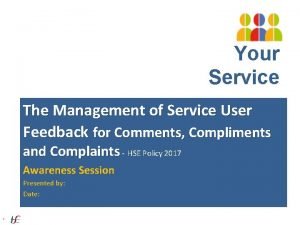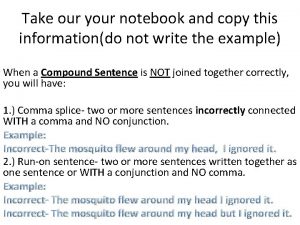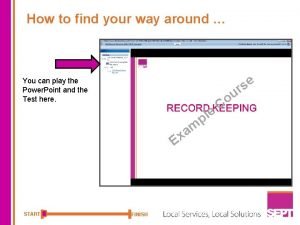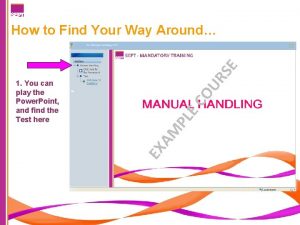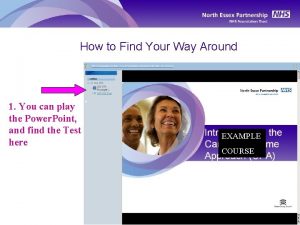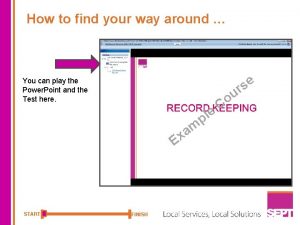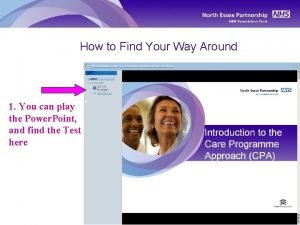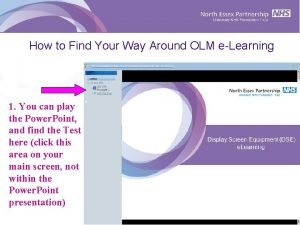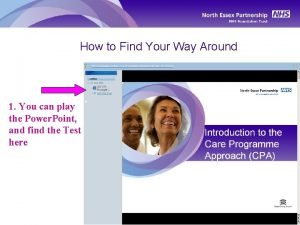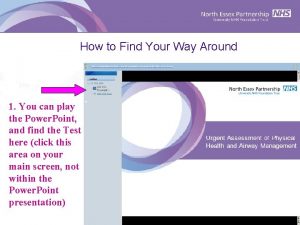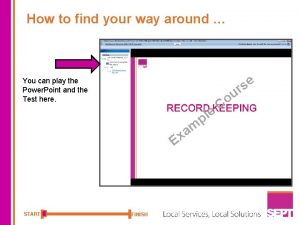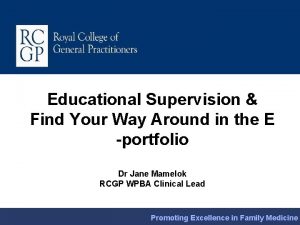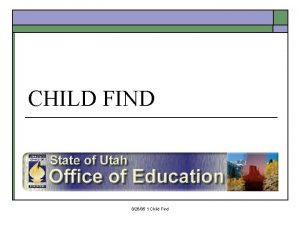How to find your way around e s




































































- Slides: 68

How to find your way around … e s r You can play the Power. Point and the Test here. u o C e l p m a x E START FINISH

How to find your way around … Always click the ‘home’ icon to save your progress and log off. e s r u o C This is important! e l p m a x E START FINISH

Looked After Children and Young People For all staff that work with looked after children and young people. The Legal Framework and Health Needs of Looked After Children – what you need to know. START FINISH

Aims and competencies By the end of this training you will: Have an awareness and understanding of the legal framework relating to looked after children and of their health needs Be able to recognise when a child is looked after and take account of their circumstances when providing care Have a greater awareness of the health needs of looked after children and young people Be able to recognise and take into consideration any additional needs that may impact on the provision of healthcare for looked after children START FINISH

Learning Objectives To ensure that all health professionals understand the legal framework relating to looked after children and their roles and responsibilities in promoting health and wellbeing To ensure that health professionals are aware of and understand the specific health needs and additional vulnerabilities of the looked after child and how they may contribute to improving their health and life outcomes To ensure that health professionals are aware of local policies and procedures and their role in providing health care To ensure that the delivery of healthcare is child focused, is sensitive to the looked after child or young person’s needs, wishes and feelings and promotes their participation To understand the role of the health professional in providing advice, support and guidance to carers to enable them to effectively care for the child in their care in light of the delegation of consent guidance To understand the inequalities in life chances children & young people who are looked after experience To understand the health professional role in respect to health representation and/or written contribution to the looked after children Statutory Review To reinforce collaborative working by health professionals on addressing health needs for looked after children

Why do children and young people become looked after? Children and young people enter the care system when their safety and wellbeing can no longer be met by their parents. Most children become looked after when the child protection plan has not been successful in addressing the issues that led to the plan being implemented. Some enter care because of family problems, parental or own health issues (mental health, disability or terminal illness) or there is no family member able to care for them. Some young people enter care because of their behaviour or offending, presenting as a risk to themselves and society (Remanded to Care). START FINISH

Legal Status A child or young person is “Looked After” under the Children Act, 1989 if he/she is accommodated by the local authority: Under a voluntary agreement with parental consent or own consent if aged 16 or 17 (Section 20) Children under 16 may be provided with accommodation by the local authority at their parents request under Section 20 of the Children Act 1989. Birth parents retain parental responsibility for their child and may take the child back at any time. Young people aged 16 or 17 years may request to be accommodated in their own right. Following the Southwark Judgement in 2009 local authorities must comply with the Children Act 1989 and assess all 16 & 17 year olds who present as homeless and provide support and accommodation for them under Section 20. Subject to a Care Order imposed by the courts (Care Order Section 31 or Interim Care Order Section 38) Care Orders are issued by the family courts where there is evidence of harm to the child and there is a need to protect the child. Parental responsibility is shared between the birth parent and the local authority. START FINISH

Legal Status Subject to an Emergency Protection Order (Section 44) Occasionally, children may be placed in care because of immediate safety concerns such as abandonment or unsafe environment. An Emergency Protection Order granted by a magistrate expires after 8 days but can be extended by a further 7 days on application. Sometimes they are allowed to lapse if the need to protect the child has passed and there is no expectation of future harm, but sometimes they are superseded by other legal proceedings (such as Care Order applications) which are intended to provide longer-term protection. Police Protection Order (Section 46) Gives the police authorisation to remove a child from the care of its parents without a court order. Police Protection Order remains in place for 72 hours during which time the police and the local authority must assess the risk to the child and either seek a court order or the parents consent to the child being looked after. If a court order or parental consent is not obtained the child must be returned to the parent. Legal Aid, Sentencing and Punishment of Offenders Act (Section 21) This Act came into force on 3 December 2012, the Act states that all children remanded by the courts will now become looked after. We would therefore expect to see more children looked after under this legal status as a result of their involvement with the criminal justice system. START FINISH

Legal Status Looked After Children placed in a secure unit are subject to a Secure Order (Section 25) Placement of a LAC in a secure unit is time limited often for a period of 3 -6 months. Home Office approval is required for children under 12 years of age. Any young person who has been in care at any time during their childhood is considered to be vulnerable and at greater need until at least their 21 st birthday (24 if in education or disabled). START FINISH

Question A Police Protection Order remains in place for 72 hours. FALSE TRUE Continue START FINISH

Adoption process: Children may be placed for adoption with either: v The consent of their birth parents v With the agreement of a court under a Placement Order A Placement Order authorises a local authority to place a child for adoption where there is no parental consent, or where consent should be dispensed with. Placement by consent is the free unconditional agreement of the parent or guardian of a child to that child's adoption. The consent can be withdrawn at any time up and until an adoption order is made. Prospective adoptive parents gain shared Parental Responsibility with the local authority and the birth parents and the child remains looked after until the Adoption Order is made final. An Adoption Order severs all legal ties with the birth family and confers parental rights and responsibilities on the new adoptive family. The birth parents no longer have any legal rights over the child and they are not entitled to claim the child back (Adoption and Children Act, 2002) START FINISH

Adoption When a child is adopted the following principles must be kept in mind: Clinical record: Although it is ended, the entire record must be maintained intact both paper and electronic. The child’s original name and NHS number must not be deleted. A new record is issued with a new NHS number and the child’s new name. Protection of the new placement: The demographic details of the new placement should be kept from the birth family members for confidentiality reasons. Confidentiality: Although most adoptions are open, care must be taken to ensure that the child’s confidentiality is maintained, i. e. telling them they are adopted when they have not been told by their adoptive parents or sharing pre-adoption information before they are ready or prepared for it. Third party information; avoid sharing demographic, health or social information relating to the birth family members with the adopted child or adoptive parent without the consent of the person to whom it relates. NB: it is proposed that the practice of issuing a new NHS number will cease; however a date has not been set for when this will happen. START FINISH

Other orders to be aware of; although these are NOT looked after children If a child is living with a close family member they are not necessarily looked after, unless they are subject to a Care Order or Section 20 in a kinship or family and friends placement. If a Special Guardianship Order (SGO) has been granted to the person they are living with. Any child who was previously looked after will cease to be looked after when an SGO is made. Special guardians have parental responsibility (PR) for the child with similar restrictions to Residence Orders but may appoint a guardian to care for the child in the event of their death. Special Guardians cannot consent to the adoption of the child. Children & Adoption Act, 2002 A Residence Order sets out whom the child should live with and not to whom the child belongs usually following divorce or separation of the parents. The holder of the order has parental responsibility for the child for the lifetime of the order or until the child reaches 16 years of age. However, PR is shared with others (i. e. birth parent) and their consent would be needed to take the child out of the country or change their name for example. Children Act 1989 START FINISH

Other orders to be aware of; although these are NOT looked after children A Supervision Order (type of supervision can vary) can be made within Care Proceedings, if the threshold criteria are met. The Supervision Order places the child under the supervision of the local authority. It does not give Parental Responsibility to the local authority. The supervisor's duty is to advise, assist and befriend the child and the court may attach certain requirements to the order for the child (and the parents) to comply with. A Supervision Order lasts for a maximum of one year and may be extended up to a maximum of 3 years but cannot be extended beyond the child's 18 th birthday. It can be discharged on application and will be discharged automatically by the making of a Care Order, Placement Order, Adoption Order or SGO. Respite Care for children using short term breaks (respite) the parents will retain the prime responsibility for ensuring the health of their child. These children do not fall into the remit of the looked after children’s service and therefore are not subject to statutory health assessments. Only children with disabilities in respite care placements lasting 28 continuous days or over 75 days total in one year are deemed to be looked after. START FINISH

Question Children may be placed for adoption with either consent of their birth parents or consent from a neighbour. TRUE FALSE Continue START FINISH

Private Fostering A Private Fostering arrangement is one which is made privately (that is to say, without the involvement of the local authority), for the care of a child. v A privately fostered child is one who, being under the age of 16 (or under 18 if disabled) is cared for and accommodated by someone other than a parent or close relative. A close relative can be a : grandparent, brother, sister, uncle, aunt or step parent. v A child is not privately fostered if the person caring for him has done so for less than 28 consecutive days and does not intend to do so for longer than that. v On identifying that a child is being privately fostered the healthcare practitioner has a duty to notify the appropriate department within the local authority v The local authority have a duty to visit the carer regularly and satisfy themselves that the child / young person is being properly cared for and that the arrangements suit all the child / young person’s needs. v Depending on the age of the child, the parent or the person with parental responsibility will give consent for all treatment or intervention for privately fostered children and young people. START FINISH

Private Fostering Privately fostered children do not fall into the remit of looked after and therefore the looked after children health team are not involved and statutory health assessments are not required. If you are concerned about a child who may be privately fostered, please discuss these concerns with the safeguarding children team and also notify the appropriate local authority services. Southend Borough Council – 01702 350430 Essex County Council - 0800 801530 (press option 1 for Fostering) For more useful information on Private Fostering go to www. privatefostering. org. uk START FINISH

Parental Responsibility: "All the rights, powers and duties of parents in relation to a child and his property“ Section 3, Children Act 1989 People with Parental Responsibility This will often, but not always, be the child’s parent. Legally, you only need consent from one person with parental responsibility, although clearly it is good practice to involve all those close to the child in the decision making process. v If a child is not competent to give consent for themselves, you should seek consent from a person with parental responsibility v Parental responsibility for looked after children is “shared" between the adult with parental responsibility and the local authority if a court order i. e. Section 31 or 38 is in place. In the case of a looked after child this would be sought and determined via the social worker on behalf of the local authority v The birth parent retains parental responsibility if a child or young person is accommodated by the local authority under Section 20, which is a voluntary agreement v However, the carer is empowered to do what is reasonable in all circumstances to safeguard and promote the welfare of the child. This does not affect any liability of the person with parental responsibility from failure to meet that responsibility START FINISH

What is delegation of authority to consent? Delegated authority is the term used when the responsibility for making day to day decisions about a child has been passed to the foster carer. This can include decisions around activities, hair cuts and overnight stays amongst other things. There is a general agreement that it is extremely important to improve practice around delegated authority in order to help young people to achieve and thrive in foster care. v The revised statutory framework for fostering and care planning, which came into force in April 2011, and the Foster Carers' Charter, outline the importance placed by the government on foster carers being able to take a greater range of decisions about day to day aspects of the lives of the young people they care for. v Children and young people say that this is important to them, as the current arrangements make them feel different from other children and also that school trips and other opportunities are sometimes missed due to delays in getting the necessary consent from managers of children’s services in social care. START FINISH

What is delegation of authority to consent? v The Fostering Network has produced robust guidance and tools to support social care with the Delegation of Authority to Consent process. A decision Supporting Tool should be used to support the process. (Fostering Network (2011) Supporting Placement Planning: handbook on delegated authority) www. fostering. net/delegated-authority v In some circumstances the local authority may seek with the persons who hold parental responsibility, for consent to be delegated to the child’s identified carers. Locally, Essex County Council have adopted the delegation of authority to consent whilst this is not the practice countrywide at present. v Delegation of consent should be set out clearly within the supporting documents that are held by foster carers and need to be seen prior to undertaking any invasive procedure e. g. immunisations, planned or non urgent surgery and CAMHS referral. START FINISH

What is delegation of authority to consent… who is responsible? This is a local authority responsibility. The local authority has to establish the process with the carers and birth parents. This is not a health responsibility. v Community and Mental Health practitioners can and should challenge if the delegation is unclear. v If the practitioner is happy that delegated authority to consent has been followed correctly, they will still need to assure themselves that the authority to consent is timely, informed and appropriate. They also need to ensure that the final decision is recorded fully in accordance with record keeping guidance. v The foster care will hold a full copy of the supporting tool and the delegation of authority to consent card and health practitioners can request to view these from the foster carer as necessary. Why Delegate? v Improves lives for looked after children. v Reduces delay for looked after children to access appropriate treatment and support as required. v Gives clarity for carers to establish what they can and can not consent to. START FINISH

Consent: Responsibility of Health Practitioners Nurses and midwives have three over-riding professional responsibilities with regard to obtaining consent: v To make the care of people their first concern and ensure they gain consent before they begin any treatment or care. v Ensure that the process of establishing consent is rigorous, transparent and demonstrates a clear level of professional accountability. v Accurately record all discussions and decisions relating to obtaining consent. NMC 2013 www. nmc. uk Other health professionals should follow their own Professional Body Regulations and Guidance If in doubt? ? If delegated authority to consent raises any concern, health practitioners should seek further clarity from social care. In an emergency situation that arises for looked after children, as with any other child, local policy and procedure should be adhered to. START FINISH

Young People and Consent Looked after children and young people should be assessed the same as any other young person in regards to being able to consent. If the person is under the age of 16 (a minor), nurses and allied health professionals must be aware of local protocols and legislation that affect their care or treatment. Consent of people under 16 is very complex, so local, legal or professional organisation advice may need to be sought. Children under the age of 16 are generally considered to lack the capacity to consent or to refuse treatment. The right to do so remains with the parents, or those with parental responsibility, unless the child is considered to have significant understanding to make up his or her own mind about it. Children of 16 or 17 are presumed to be able to consent for themselves, although it is considered good practice to involve the parents. Parents or those with parental responsibility may override the refusal of a child of any age up to 18 years. In exceptional circumstances, it may be necessary to seek an order from the court. NMC 2013 www. nmc. uk Fraser or Gillick competency should be assessed and applied on an individual basis as appropriate. If there any concerns, the social worker should be contacted, ensuring that the young person is aware that the information is to be shared. START FINISH

Quiz part I Chantelle is cared for by her grandmother who has obtained a Special Guardianship Order. Chantelle has been seen by the dentist as she is complaining of toothache and requires antibiotics and a filling. Chantelle’s grandmother can give consent for this? TRUE FALSE Julia is 15 years of age and is looked after under Section 20. She has attended her local sexual health clinic for emergency contraception and can give consent for this herself? TRUE Philippa is planning to adopt Sian, who is placed with her and her husband under a Placement Order. Sian has been brought to the surgery for her pre-school immunisations and Philippa can give consent for these? TRUE START FALSE Continue FALSE FINISH

Quiz part II David is 5 years old and is subject to an Interim Care Order. Matthew, David’s foster carer has taken him to the optician. Is Matthew able to give consent for an eye test? TRUE FALSE Tony, aged 10 years receives respite care as he has physical disabilities. His parents will give consent for surgery to correct a spinal problem? TRUE Johnny aged 14 years has been exhibiting challenging behaviour, lashing out, absconding from placement and cutting himself. He requires referral to the local CAMHS. The foster carer can give consent for this? TRUE START FALSE Continue FALSE FINISH

The Health of Children and Young People in Care “Looked after children share many of the same health risks and problems of their peers, but often to a greater degree, and in the context of greater challenges such as discord within their own families, frequent changes of home or school and lack of access to the support and advice of trusted adults. Children often enter the care system with a worse level of health than their peers, in part due to the impact of poverty, poor parenting, chaotic lifestyles and abuse or neglect…. The fact that longer-term outcomes for looked after children remain far worse than their peers is evidence of an important health inequality, and needs to be treated as a public health priority. ” (Promoting the Health of Looked After Children: A study to Inform Revision of the 2002 Guidance, Research Report DCSF RR 125, Thomas Coram Research Unit, June 2009) One does not need to be told the importance of health. Poor health can impact on all other aspects of life and more so for looked after children “Good health is essential for all children and young people. It enables them to enjoy life, gain the most from their education and improves life chances” (Harris & Woodhouse 2009) START FINISH

Kay Statistics – Department for Education 2013 There were 68, 110 looked after children at 31 March 2013, an increase of 2% compared to 31 March 2012 and an increase of 12% compared to 31 March 2009 There were 28, 830 children who started to be looked after during the year ending 31 March 2013, an increase of 2% from 2012 and an increase of 12% from 2009 There were 3, 980 looked after children adopted during the year ending 31 March 2013, an increase of 15% from 2012 and an increase of 20% from 2009 and it’s now at its highest point since the start of the current data collection in 1992 There were 28, 460 children who ceased to be looked after during the year ending 31 March 2013, an increase of 3% from 2012 and an increase of 14% from 2009 At 31 March 2013, 40, 180 children were looked after under a Care Order (either an Interim or Full Care Order). This represents 59% of all legal statuses of looked after children At 31 March 2013 there were 18, 190 children looked after under a voluntary agreement under Section 20 of the Children’s Act Of children looked after at 31 March 2013, 50, 900 were cared for in a foster placement. The number of children placed in foster care has increased by 16% since 2009 The majority of children looked after at 31 March 2013 (74%) are from a White British background. The ethnic breakdown for children looked after has varied little since 2009 The percentage of looked after children cared for in foster placements was 72% in 2009, in 2013 it has increased to 75% The majority of looked after children – 62% in 2013 are in care due to abuse or neglect Around 5% of looked after children are unaccompanied asylum seekers There were 3, 350 looked after children placed for adoption at 31 March 2013. This is an increase of 16% from 2012 and an increase of 25% from 2009

Measuring Outcomes and Performance for LAC The performance of local areas in meeting the health needs of looked after children is monitored in a number of ways. Published data: Nationally, outcomes for looked after children are measured by the Department for Education through; v Number of those up to date with their immunisations v Number who have had a dental check up v Number who have had their annual health assessment v Emotional and behavioural health v Substance misuse v Academic attainment v Offending CQC Inspections: The Children’s Services Inspection team is undertaking a targeted review of how well local health services identify, help, protect and provide child-centred care and to ensure that children’s health needs are effectively met. Inspectors will evaluate the quality and impact of local health arrangements for improving health outcomes for children who are looked after and the effectiveness of safeguarding arrangements within health for all children. This includes mapping the child’s journey at all stages – from pre-birth through to their transition to adulthood, and from the point of their entering to leaving care. START FINISH

Measuring Outcomes and Performance for LAC NICE guidance and quality standard is designed to help children services meet their obligations to improve the health and well being of looked after children and young people. The Public Health Outcomes Framework includes an indicator on the emotional wellbeing of looked after children as well as many indicators that would be relevant to efforts to improve the health outcomes of looked after children. Local Key Performance Indicators: v Health summary received by young people when leaving care v Notification to the child and carer of their Lead Health Professional v Training of all those who undertake health assessments for looked after children as well as all practitioners who work with children v Initial Health Assessments completed within timescale v Review Health Assessments completed within timescale v Quality of Health Assessments audited using Payment by Results Guidance START FINISH

The Impact of Entering Care Separation from, or loss of family, siblings and friends The family ties of children and young people entering care may be broken in order to assure their safety or wellbeing and sibling group placements may not initially be available. They may be placed far from where they originate meaning changes of school. Some enter care because of the death of their parent or carer. Anger/fear They may be angry at being removed from their family and friends and not fully understand the reasons why they are in care. They may be fearful of their new carers and of what their future may hold. They may feel they are to blame for the family problems. Attachment/detachment/re-attachment Each placement change means they have to break with a carer and build relationships with a new carer, adjust to a new environment and family culture. This pattern may be repeated several times START FINISH

The Impact of Entering Care Loss of choice or involvement in decisions about their lives It is inevitable that there will be a loss of choice and involvement in decisions about their lives initially in order to protect them. Loss of identity All these impact on the child or young person’s sense of self and self-worth. If not recognised and managed well it can lead to poor resilience, emotional and mental health problems (including risk taking/self harming behaviours), lower educational attainment and poor outcomes in adult life. START FINISH

Why is Health Input Important for LAC – Physical Health Looked after children’s physical health is poorer than that of other children due to their life experiences prior to entering care. A national survey found two thirds of all looked after children have at least one physical health complaint (Meltzer et al, 2002). This is also reflected in the local looked after children cohort, in a survey completed in 2011 in South East Essex in which 94% of the children and young people were identified as having one or more physical health need. 52% of looked after children have a health condition requiring hospital care (Skuse, 2002). Looked after children are more likely than their peers to experience problems including speech and language problems, bedwetting, coordination and eye or sight problems (Meltzer et al, 2002). START FINISH

Why is Health Input Important for LAC – Physical Health Often looked after children have poor immunisation, dental and vision check uptake. As of 31 st March 2012, 83. 1 per cent of looked after children were up to date with their immunisations and 82. 4 per cent had their teeth checked by a dentist within the previous 12 months. Health tends to worsen once young people leave care, with increased problems with drugs and alcohol, mental health problems and other health issues such as weight loss, asthma, allergies, flu and illnesses related to drug or alcohol misuse and pregnancy. The recommendation from CQC is that all young people preparing to leave care must be provided with a summary of their health information. START FINISH

Why is Health Input Important for LAC – Emotional Mental Health v About 60% of those looked after in England have been reported to have emotional and mental health problems, around four times the rate for children generally (NICE, 2010). This is comparative to the local data in South East Essex which showed 53. 4% in 2011 for the looked after children cohort. v Under the age of 5, nearly 1 in 5 showed signs of emotional or behavioural problems (Sempik et al, 2008). v Among 5 -10 year olds, 50% of boys and 33% of girls had an identifiable mental health disorder (Sempik et al, 2008). v In 11 -15 yr olds, 55% boys and 43% girls have an identifiable mental health disorder, compared to only 10% of the general population(Sempik et al, 2008). START FINISH

Why is Health Input Important for LAC – Emotional Mental Health v The limited resources of the mental health services can be challenged in addressing the often complex or undiagnosed mental health needs of looked after children (NCB 2013). v There is evidence that looked after children experience particular mental health stigma (Young Minds, 2011). v Looked after children have a Strength and Difficulty Questionnaire completed. The score provides a prediction about how likely it is that a child or young person has significant mental health problems and therefore whether further assessment is needed. START FINISH

Question What percentage of looked after in England have been reported to have emotional and mental health problems? 60% 55% 65% 50% Continue START FINISH

Strengths and Difficulties Questionnaire (SDQ) v The SDQ is a short behavioural screening questionnaire. v It has five sections that cover details of emotional difficulties; conduct problems; hyperactivity or inattention; friendships and peer groups; and also positive behaviour, plus an “impact supplement” to assist in the prediction of emotional health problems. v It is completed by the child’s main carer for all children aged between 4 and 16 years who have been in care for at least 12 months. Supplementary information may also be sought via a teacher questionnaire. v The Total Strengths & Difficulties Score provides a prediction about how likely it is that a child or young person has significant mental health problems – unlikely, possible or probable - and therefore whether further assessment is needed. START FINISH

Strengths and Difficulties Questionnaire (SDQ) Scores are broken down into 2 categories: v 0 -16 considered acceptable score normally no further action is required v 17 and above is an unacceptable score therefore further investigations required v Such high scores warrants referral to CAMHS services and an action plan drawn up for the child. START FINISH

Why is Health Input Important for LAC - Education Looked after children are likely to lose time in school as a result of no school place being secured, poorly managed transitions, re-integration from out of authority placements/special provision, or exclusion from school; however with the introduction of the looked after children virtual head teachers this has changed dramatically as they work with the school and child to avoid exclusion. Looked after children are around ten times more likely than their peers to have significant learning difficulties, which for many will have implications for how they are best supported to understand health messages, manage risk and be engaged in decisions about their health. 73 per cent of school age children, who are looked after continuously for a period of 12 months have some form of special educational needs. As looked after children are at greater risk of exclusion from school and more likely to truant, they often miss out on health interventions delivered in school, including health promotion messages and health protection measures such as immunisations and sex and relationships education. It is essential to make sure there are links with the designated teacher within schools responsible for looked after children to improve communication and address specific needs for individual children. The designated teacher may have an awareness of specific issues going on for the child but may not always be aware of available services to link in with and refer the child to. START FINISH

Why is Health Input Important for LAC – Education v In 2012, only 14. 6% of children in care achieved 5 A*-C grades at GCSE (or equivalent) compared to 58. 1% of non-looked after children. v The rate of overall absence for children looked after continuously for 12 months at 31 March 2009 was at 6. 2 per cent, slightly lower than the rate for all children. v 34% of care leavers aged 19 who are not in education, employment or training and care leavers are less likely to go into further education compared to the general population of young people. v Research in several countries has shown how poorly equipped many young people leaving care to cope with life after care – practically, emotionally and educationally – and has made connections with their subsequent experiences of loneliness, isolation, poor mental health, unemployment, poverty, drift and homelessness. START FINISH

Why is Health Input Important for LAC – Substance Misuse v Looked after children and young people around three times more likely to drink regularly and more likely to smoke than their peers. They are around four times more likely to simultaneously be a smoker, regular drinker and drug user (Meltzer et al, 2002). v As at the end of March 2011, 4. 3% of looked after children and young people were identified as having a substance misuse problem during that year. v School nurses are well placed to support and work with the schools, through children accessing drop ins and building a trusting relationship to promote the importance of health education and promotion. v Building relationships will potentially enable young people to gain the confidence to access intervention services such as Young People’s Drug and Alcohol services as required. START FINISH

Why is Health Input Important for LAC – Offending Behaviour v As at the end of March 2011, 7. 3% of looked after children and young people aged between 10 -17 years had been convicted or subject to a final warning or reprimand during the year. v One third of all children and young people in contact with the criminal justice system have been looked after (Df. CS&F and DH 2009). v However a substantial majority of young people in care who commit offences had already started to offend before becoming looked after (Darker et al, 2008). v Anecdotally, there is a huge link between substance misuse and offending behaviour amongst looked after children; therefore working and supporting them to address issues around emotional, mental and substance misuse areas will have a positive impact on offending behaviour. v Identifying looked after children and young people already involved or likely to become involved with the youth offending service is helpful in promoting partnership working and reducing duplication of statutory planning meetings. START FINISH

Why is Health Input Important for LAC – Early Parenthood v Risky behaviour such as unprotected sex also appears to be particularly prevalent in looked after young people (Meltzer et al, 2002). v Both looked after young women and young men are more likely to become teenage parents than their peers (Df. ES, 2005). v In 2010, 350 girls in care aged 12 years and over were mothers. 170 were under 16 when they gave birth. v From research in England, it is estimated that a quarter of young women leaving care pregnant or have a child and that the numbers of young women who give birth increases within 18 -24 months of leaving care. START FINISH

Why is Health Input Important for LAC – Early Parenthood If they become pregnant while in care, young women may experience particular difficulties: v Many do not receive neutral, unbiased advice about all the possible options, or counselling to help them make a decision and some may experience pressure to have an abortion. v As a group, looked after children are more likely than others to be against abortion and many would not consider giving their baby up for adoption. v Most have received little education about parenthood either from school or whilst in care and many do not attend locally available ante-natal and parent education classes. v Pregnancy brings health risks for all mothers particularly to those very young and on average poor outcomes for the resulting children. The lowest proportion of contraception or condom use was found in cases where intercourse was unexpected and/or carried out for the first time with a partner of less than a month’s duration and such unprotected sex carries the greatest health risks. v However pregnancy for looked after children is not always a negative thing, for some it may be a positive and rewarding choice. START FINISH

Why is Health Input Important for LAC – Disability Children with disabilities in care may be accommodated for many reasons: v Family unable to meet the child’s increasing care needs v Family stress due to the child’s needs v Abuse or neglect v They may have had many carers providing respite care and may lose contact with their birth family as they are more likely to be placed long distances away from their families due to requiring specialist services. v Disabled children, including children with emotional and behavioural difficulties, are more likely to be looked after than children without disabilities. START FINISH

Why is Health Input Important for LAC – Disability v Disabled looked after children are particularly vulnerable as many have limited communication skills and have complex care needs. And puberty may bring additional challenges for carers in supporting the young person not only in meeting their care needs but also in establishing their sexual identity. v Challenges may present in consulting with disabled looked after children due to the complexities of their presenting needs and there may not be adequate communication systems in place. v Many disabled young people moving from child to adult services may experience difficulties receiving information or advice about healthy living, including sex and relationships education. v For many disabled young people, transitions from care may be abrupt or delayed by restricted housing and employment options and adequate support being available. START FINISH

Health Needs of Specific Groups v Unaccompanied Asylum Seeking Children (UASC): They may have entered the country for a variety of reasons: trafficking, escaping war or famine for example. They may have entered the country on their own or accompanied by a family “friend or relative” and then been abandoned. Prior to arriving they may have suffered hunger, physical and sexual abuse or have witnessed or participated in extreme violence (i. e. genocide or child soldiers). Their health history is often unknown including immunisation status, they may have unidentified health problems such as HIV and they may have an increased likelihood of mental health problems. In addition to these problems and the separation from family and friends there may be difficulties in meeting their religious, social and cultural needs. These young people may have significant sexual and psychological problems. START FINISH

Health Needs of Specific Groups v Black and Minority Ethnic children (BME) : BME children may not be placed with carers who share the same ethnicity, religious or cultural background as themselves. There may be difficulties in language, diet and daily routines. v Gay/Lesbian/Bi-sexual/Transgender young people (GLBT): The emerging sexual identity can be challenging and confusing for any young person but particularly for those who find themselves attracted to their own sex or have difficulties identifying with their physical gender. Young people in care more likely to have problems in developing their sense of self and this can be much more difficult if they also have difficulties with their sexual identity. They are at an increased risk of mental health problems. START FINISH

Reasons for Poor Health in Looked After Children and young people taken into care likely to have experienced a range of disadvantages, such as poor health, poverty, absent, limited or inappropriate parenting. v The family lifestyles of children taken into care have often been disrupted and chaotic. v The majority of children are taken into care as a result of abuse or neglect. v Many children taken into care have experienced acute stress and tensions within their families. v Children may have been neglected prior to entering care which encompasses all the categories of abuse. v Parental lifestyle choices e. g. alcohol & substance misuse. v Genetics v Disability and /or mental health problems v Poor access to health services as a result of parents not engaging. v Frequent changes of placement leading to missed and delayed appointments Care may fail to repair and protect health and may even exacerbate and damage; therefore as health professionals you are within your right to challenge practices that are not putting the child at the centre of the care. START FINISH

Contributing Factors to Poor Health in LAC v Poor recording keeping and hand over processes between professionals and agencies. v Delayed transfer of health records resulting in missed appointments. v Placements made in and out of area with no notification or communication to enable follow up and monitoring of health needs. v Not registered or temporary registration with GP therefore health record not transferred to new GP practice. v Birth parents absent or not engaging therefore not providing appropriate consent and information. v Frequent changes of placement, foster carer, social worker, GP, health practitioner and school. v Instability and insecurity of placement leading to attachment – detachment – attachment perpetuating the cycle START FINISH

Roles and Responsibilities v GP – is the primary record holder. The child or young person must be registered fully with a GP local to the placement. v Lead Health Professional – undertakes health assessments, co-ordinates and monitors health care plan, acts as key health contact for social workers and carers. The looked after child lead health professional is often the child’s Health Visitor, School Nurse, Health Advisor for looked after child depending on the child’s age. The lead health professional is responsible for writing and submitting the report as well as attending the looked after child statutory review meetings. v Looked after children’s team – co-ordinates the overall looked after children service in provider health organisation. The team consists of an Administrator, Health Advisor & Specialist or Named nurse. v Designated Doctor and Nurse – holds a strategic role within the commissioning organisation to assist health bodies and social care in fulfilling their responsibilities as corporate parent for the child or young person. START FINISH

Duty to Cooperate Health organisations have a duty to co-operate with requests from the local authority to carry out statutory health assessments on looked after children (Section 10, Children Act, 1989): v Initial Health Assessment (IHA): is undertaken within 4 weeks of child becoming looked after. The IHA is undertaken by a registered medical practitioner, ideally a paediatrician. It may also be carried out up to 3 months prior to the child becoming looked after if accommodation is the plan for the future. v Review health assessments (RHA): may be carried out by a registered nurse or midwife. v Under 5’s - The review health assessment in undertaken at 6 monthly intervals and they must have had a health assessment completed in each 6 month period (i. e. 1 in the period 1 st April to 30 September, and 1 in the period 1 st October to 31 st March to comply with statutory requirements). v Over 5’s – The review health assessment is undertaken at 12 monthly intervals. The over 5’s must have 1 completed within each year (1 st April to 31 st March). START FINISH

Confidentiality and Information Sharing Under 16’s, including looked after children, are as entitled to have their confidentiality respected as anyone else with the following exceptions: v The young person (if competent), or the person with parental responsibility has consented to the information being shared. v The information is being shared in the best interests of the child in order to provide appropriate care or where there are child protection concerns. v The information is being shared in the public interest in order to report or prevent a crime. v Disclosure is required by the order of a court. The Caldicott Principles are: v v v Justify the purpose(s) of every proposed use or transfer Don't use personal confidential data unless it is absolutely necessary Use the minimum necessary personal confidential data Access to personal confidential data should be on a strict need-to-know basis Everyone with access to personal confidential data should be aware of their responsibilities v Comply with the law v The duty to share information can be as important as the duty to protect patient confidentiality Information: To share or not to share? Information Governance review (DH, 2013) START FINISH

Practice Guidance and Care Pathway for Children and Young People in Care who are admitted to Psychiatric In-Patient Units, May 2013 Developed following the death in 2009 of a young person who was ‘Looked After. ’ Sets out the key roles and responsibilities in ensuring the health and care planning needs of the young person requiring Tier 4 CAMHS are met within a multi-agency framework. The next few slides shows the flow chart and an example of an admissions notification form, which are all in the Practice Guidance and must be followed and completed when a looked after child is admitted to Poplar Unit. Please refer to the attached document START FINISH

Question What is not a contributing to poor health in LAC? Poor mobile phone signal Lack of recreational parks Delayed transfer of health records School dinners Continue START FINISH

Flow Chart • Admission • Keyworker notifies Named/Allocated Social Worker and Designated Nurse, Looked After Admission Children within 1 working day of admission. Where identity of SW is not known, relevant Director of Local Delivery is informed. • Named/Allocated Social Worker confirms legal status of Young Person and details about birth parents / contacts and any other relevant information necessary to manage risk within 3 working days of admission. SW informs IRO and Director of Local Delivery and updates on 3 working weekly basis days • Named/Allocated Social Worker immediately commences work to identify what further support may be required by placement to ensure young person is able to return to placement at earliest opportunity or where placement has irretrievably broken down to identify an alternative placement • Designated Nurse; Looked After Children confirms identity of Lead Health Professional and any significant health information to enable management of risk within 3 working days. lead Health professional liaises with inpatient unit regarding physical health checks • Initial Formulation Meeting held within 10 working days - convened by member of Unit Multidisciplinary team - often the young person's keyworker in collaboration with their CPA 10 working Coordinator days • Named/Allocated SW and Lead health Professional must attend. • CPA Coordinator and Clinicians from In-patient Unit attend 4 weeks post admission • First CPA Review - convened by CPA Coordinator • Named/Allocated SW and Lead health Professional must attend. • CPA Coordinator and Clinicians from In-patient Unit attend • YP advocate invited

Flow Chart 6 weekly Discharge Planning Meeting Discharge • CPA reviews - convened by member of Unit Multi-disciplinary team - often the young person's keyworker in collaboration with their CPA Coordinator • Named/Allocated SW and Lead health Professional must attend. • CPA Coordinator and Clinicians from In-patient Unit attend • YP advocate invited • Timing according to clinical need. IRO may attend in observational capacity but is clearly expected to agreed discharge plan • Discharge plan must be communicated in writing to all relevant professionals - by CPA Coordinator • Clear coherent CPA Plan in place detailing follow-up arrangements, supports available to young person and their carers, any specific care issues, contact arrangements and date/time of Statutory CLA Review. CPA Plan should be consistent with young person's physical health care plan. • Postdischarge Follow-up START CLA review must occur within 8 working days of discharge, chaired by the IRO. The young person's CPA Coordinator, Named/allocated SW and their team manager, the Lead health professional and the young person's keyworker from the respective unit must attend. FINISH

Childs Name and Date of Birth Jane SMITH 26/10/1998 NHS Number 642 333 5678 Home Address 6 The Mount, Hillside, Middleshire. Foster Carer: Jennie Minns Originating address if different to above 72 Long Street, Upshire Legal status of child (if known) S 20 Details of allocated Social Worker James Johns Responsible local authority Upshire Local Authority Details of GP: name, address and contact Dr Jones, The Surgery, Hillside. 01333 333222 School (if in education) Upshire Academy Reason for and date of admission inclusive of route (voluntary/detained) Admitted from A/E for assessment under Section 2 Mental Health Act 1983 on 20/11/2013. Self Harming. Ward/Keyworker Josie Jones, Staff nurse, Longview Date of last health assessment (if known) Not known

Looked After Children Statutory Reviews Looked after children statutory reviews: Are a platform to enable all those involved in the child’s life (i. e. the child, their families, carers and professionals) to consider, review and plan the care arrangements for the child through being active participants through partnership working and effective information sharing in the review process. They must be child centred and child focused. Statutory reviews are held at regular intervals from when a child first becomes looked after with the 1 st review at 4 weeks, the 2 nd review 3 months later and the 3 rd and subsequent reviews 6 monthly. The lead health professionals are required to attend the statutory reviews especially where the case is deemed complex with outstanding and unmet health needs. A statutory review report must be completed by the lead health professional co-ordinating care given by other health practitioners and shared with the child, young person and birth family where possible prior to the review, and copied to the looked after children health team. START FINISH

Looked After Children Statutory Reviews Where they are unable to attend a report should be provided to the social worker and Independent Reviewing Officer 5 days prior to the statutory review date. The looked after children review template is on System. One. A health care plan will be formulated at the review. It should set out both short-term and long-term objectives together with the actions needed to achieve them. It should address how to provide health advice and health promotion, including age appropriate information on lifestyle, diet, exercise, sexual and risk taking behaviour (e. g. substance misuse) in addition to guidance and support on the management of specific health problems. The lead health professional should respect the child or young person’s privacy when discussing health issues. Health Visitors and School Nurses must record the date of the statutory review and a summary of the outcomes on Systm. One. START FINISH

Looked After Children Statutory Reviews Copies of the minutes from the review meetings must be scanned onto the System. One record. If professional support is required contact the looked after children health team. START FINISH

Health Information Personal Child Health Record (PCHR or Red Book) The PCHR must be kept with the child in placement. If the birth parent declines to relinquish the PCHR or it is lost a new book must be provided to the carer with key information including immunisations and birth details (weight and APGAR score etc) added. Health records Paper and electronic health records must be kept up to date and transferred promptly to the new health professional, if necessary, when a child moves placement. The transfer of paper records must have a completed transfer summary attached. Electronic shares must indicate that the child is looked after and any up coming needs or concerns documented. Carer to Carer Health Information form Carers are required to complete the carer to carer transfer of information form which should go with the child and not via the social worker. This form provides essential information to the carer including current medication, health, dental and optician appointments and any other problems. START FINISH

Health Information Consent to share health information At entry to care the person with parental responsibility (birth parent or local authority, if appropriate) is asked to consent to their child’s and their own health information being shared. It is the social workers responsibility to obtain the consent from the parent and forward to the looked after children's health team, and is scanned onto System. One. Care Leavers Health Passport A health information booklet has been developed to ensure that care leavers are provided with a complete summary of their health history when they leave care, to include information such as their birth details, summary of health needs and immunisation history. Transitions When a child leaves care and returns to their family, special guardian or adoption any outstanding needs arising from their health care plan must be completed. Young people preparing to leave care for independence or transfer to adult services must have a transition care plan. START FINISH

Policy Framework Local policies and procedures have been developed to reflect local implementation of legislation, statutory guidance and NICE public health guidance. Listed below are useful resources for information on looked after children, adoption and care leavers v v v v Children Act 1989 (plus statutory regulations & instruments) Children Act 2004 Adoption & Children Act, 2002 Children (Leaving Care) Act 2000 Children & Young Persons Act 2008 Children & Young People’s NSF Care Matters: Time for Change for Children in Care, 2008 PSA 12: Improve the health and wellbeing of children & young people, April 2008 PSA 13: Improve children & young people’s safety, April 2008 Children & Young People’s Plan Healthy Lives, Bright Futures 2009 Statutory Guidance on Promoting the Health & Wellbeing of Looked After Children, November 2009 Safeguarding Children and Young People: roles and competencies for health care staff. Intercollegiate Document, September 2010. NICE/SCIE Public Health guidance 28: Promoting the Quality of Life for Looked After Children & Young People 2010 Caldicott F (2013) Information: to share or not to share? The information governance review Legal Aid , Sentencing and Punishment of Offenders Act 2012 START FINISH

Looked After Children Health Team South East Essex • • • Named Nurse 01268 464 622 Health Advisor 01268 464 617 Team Administrator 01268 464 621 West Essex • • Specialist Nurses 01279 694942 Team Administrator 01279 694942 START FINISH

Remember, if you want to find more information / evidence about this subject or anything else which is relevant to your work or study, join your local healthcare library. For staff in Essex contact Basildon Healthcare Library. www. btuheks. nhs. uk library@btuh. nhs. uk 01268 524900 EX 3594 It may be that you work in a different area, for example Luton. Details of all the Health Libraries in the East of England can be found at this site… www. eel. nhs. uk You are welcome to join any of these. START FINISH

Review of Objective(s) Before completing the test, please ensure you have acquired the relevant knowledge against the modules objective(s) below: Have an awareness and understanding of the legal framework relating to looked after children and of their health needs Be able to recognise when a child is looked after and take account of their circumstances when providing care Have a greater awareness of the health needs of looked after children and young people Be able to recognise and take into consideration any additional needs that may impact on the provision of healthcare for looked after children If not, please take this opportunity to revisit the presentation content. CONTINUE START FINISH

You now need to take the test! e s r p e l m a x E START FINISH u o C Remember to click the ‘home’ icon when you have finished the test to save your results!
 What goes around comes around example
What goes around comes around example Martin luther king of hinduism
Martin luther king of hinduism Restoring lost body fluids.
Restoring lost body fluids. Frequency trig
Frequency trig Perbedaan one way dan two way anova
Perbedaan one way dan two way anova Threaded binary tree definition
Threaded binary tree definition Perbedaan anova one way and two way
Perbedaan anova one way and two way Hypothesis for two way anova
Hypothesis for two way anova One way anova vs two way anova
One way anova vs two way anova Contoh soal uji two way anova
Contoh soal uji two way anova Conventional software
Conventional software This way that way over the irish sea
This way that way over the irish sea Walk this way talk this way
Walk this way talk this way Give us your hungry your tired your poor
Give us your hungry your tired your poor Learning task 2 look around your home make a list
Learning task 2 look around your home make a list The american embassy adichie
The american embassy adichie Toe dancers muscle a two bellied muscle of the calf
Toe dancers muscle a two bellied muscle of the calf Fastest way to find a job
Fastest way to find a job Find the diagonal way from start to finish
Find the diagonal way from start to finish Hope quotes in the great gatsby
Hope quotes in the great gatsby Beautiful paradise economical are examples
Beautiful paradise economical are examples Words their way upper level spelling inventory
Words their way upper level spelling inventory Show me your way lord
Show me your way lord Learn your way
Learn your way Whole person paradigm
Whole person paradigm How to make a pirate name
How to make a pirate name Find your graphics card
Find your graphics card How to find your pirate name
How to find your pirate name Find the meaning of the following words!
Find the meaning of the following words! What did you do last week?.......in the pool.
What did you do last week?.......in the pool. Place value rounding numbers
Place value rounding numbers While cleaning your apartment you find a $50 bill
While cleaning your apartment you find a $50 bill Look at the following words
Look at the following words Hatchet vocabulary
Hatchet vocabulary Find your college match
Find your college match Aed locator app
Aed locator app Accept your loneliness you are your only friend
Accept your loneliness you are your only friend Stop blaming your parents for your problems
Stop blaming your parents for your problems What does the heart do
What does the heart do Pencil poem for child
Pencil poem for child How to introduce your friend to your teacher
How to introduce your friend to your teacher Wear your heart on your sleeve idiom meaning
Wear your heart on your sleeve idiom meaning Write your answer on your notebook
Write your answer on your notebook In your notebook describe the following
In your notebook describe the following Change your water change your life
Change your water change your life Your conscious awareness of your own name and self identity
Your conscious awareness of your own name and self identity Loss of forward vision
Loss of forward vision Examples of ideal self and real self
Examples of ideal self and real self Magazine article example for students
Magazine article example for students Where your treasure is there your heart
Where your treasure is there your heart Serve the lord in the days of your youth
Serve the lord in the days of your youth Rascal flatts my wish for you
Rascal flatts my wish for you Your passenger jammed his finger in the door of your m1114
Your passenger jammed his finger in the door of your m1114 First go and be reconciled to your brother
First go and be reconciled to your brother Each proportion write your answer in your notebook
Each proportion write your answer in your notebook In your notebook write down the times
In your notebook write down the times Treasure what you have
Treasure what you have What's your name? how old are you?
What's your name? how old are you? Wash your hands put on your nightgown analysis
Wash your hands put on your nightgown analysis Your health is your responsibility
Your health is your responsibility Eyes of slat
Eyes of slat Does your walk match your talk
Does your walk match your talk You put your right foot in
You put your right foot in Fight for your family nehemiah
Fight for your family nehemiah Your vote your choice
Your vote your choice Your service your say
Your service your say In your notebook write down the times
In your notebook write down the times If your instructor were to ask if you cleaned up your room
If your instructor were to ask if you cleaned up your room Copy to your notebook
Copy to your notebook
























